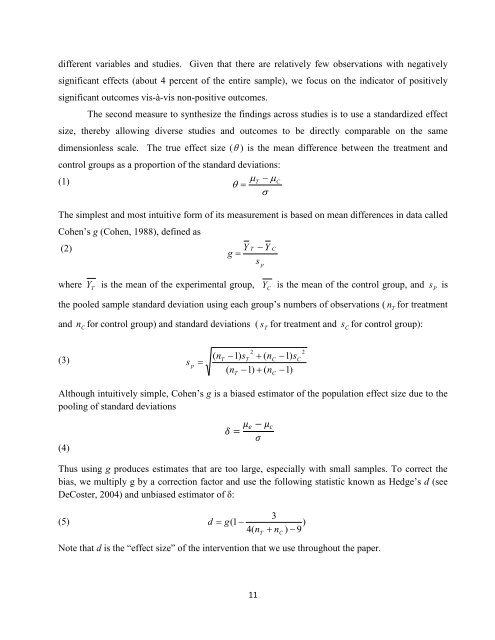Entrepreneurship Programs in Developing Countries: A ... - IYFLive.net
Entrepreneurship Programs in Developing Countries: A ... - IYFLive.net
Entrepreneurship Programs in Developing Countries: A ... - IYFLive.net
Create successful ePaper yourself
Turn your PDF publications into a flip-book with our unique Google optimized e-Paper software.
different variables and studies. Given that there are relatively few observations with negativelysignificant effects (about 4 percent of the entire sample), we focus on the <strong>in</strong>dicator of positivelysignificant outcomes vis-à-vis non-positive outcomes.The second measure to synthesize the f<strong>in</strong>d<strong>in</strong>gs across studies is to use a standardized effectsize, thereby allow<strong>in</strong>g diverse studies and outcomes to be directly comparable on the samedimensionless scale. The true effect size ( ) is the mean difference between the treatment andcontrol groups as a proportion of the standard deviations:(1)T C The simplest and most <strong>in</strong>tuitive form of its measurement is based on mean differences <strong>in</strong> data calledCohen’s g (Cohen, 1988), def<strong>in</strong>ed as(2)Yg where YTis the mean of the experimental group,YCis the mean of the control group, and sPisthe pooled sample standard deviation us<strong>in</strong>g each group’s numbers of observations ( n Tfor treatmentand nCfor control group) and standard deviations ( s Tfor treatment and sCfor control group):T YspC(3)sp( nT21)sT ( n( n 1) ( nTCC1)s1)2CAlthough <strong>in</strong>tuitively simple, Cohen’s g is a biased estimator of the population effect size due to thepool<strong>in</strong>g of standard deviations(4)δ = μ e − μ cσThus us<strong>in</strong>g g produces estimates that are too large, especially with small samples. To correct thebias, we multiply g by a correction factor and use the follow<strong>in</strong>g statistic known as Hedge’s d (seeDeCoster, 2004) and unbiased estimator of δ:3(5) d g(1)4( n T n C) 9Note that d is the “effect size” of the <strong>in</strong>tervention that we use throughout the paper.11
















